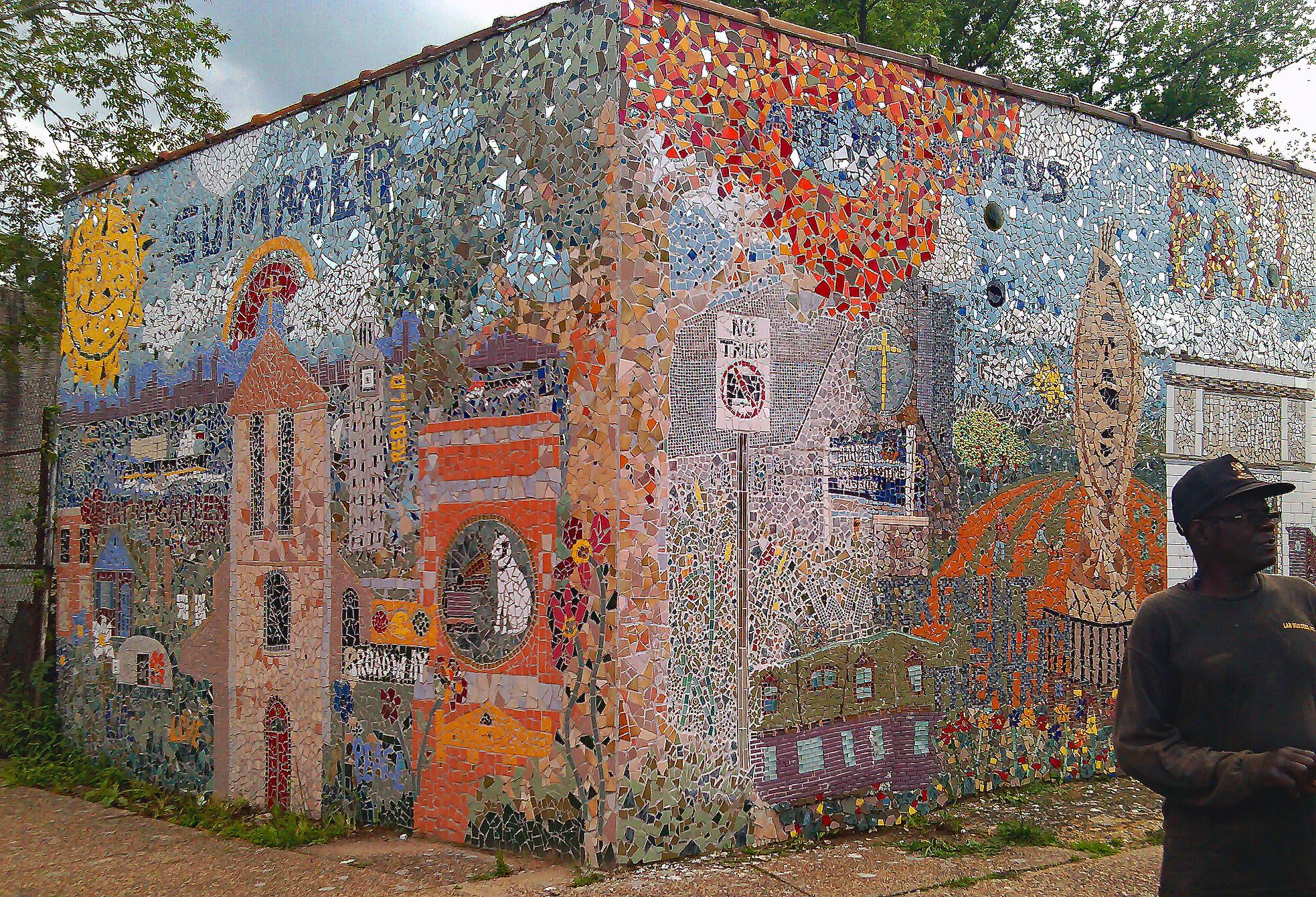We are so saddened to learn that long time MSoP member, artist and educator Janis Pinkston passed away recently. This feature article was published in 2021 and honors Janis and her amazing body of artwork. A youtube video interview of Janis can be viewed here : https://www.youtube.com/watch?v=5-5m_-yrxW0.
A memorial service is planned for March 31, 2023. Please contact MSoP for additional information @ mosaicsocietyofphila@gmail.com.
RIP dear friend!
Janis Pinkston is an artist. She sculpts, she sketches, she paints, she crochets, she creates textiles, she prints, she has written and illustrated a book. But wait, there’s more - she also creates mosaics! Many of us who look for outlets for our creativity often land on one medium and attempt to master it (or at the very least create things we’re proud of). Janis’s talents appear to be limitless. She doesn’t just dabble; she has mastered all these things.
According to Janis, “each medium informs the others.” She says galleries often like work that is formulaic; that is to say they like a body of work that is all one style and “easily recognizable as being by one particular artist.” Janis says this can be a challenge as it is sometimes hard to “squeeze all your artistic energy” into one thing. While she says many of her favorite artists have done just that, she feels that it’s a real challenge not to be distracted by variations and possibilities. Despite what she believes gallery owners are looking for, her advice to young artists is to experiment. She recommends trying as many forms of expression as possible. When you look at Janis’s work on her website, you can see she takes her own advice. There are so many different types of work to look at. It’s almost as if Janis is offering us a choice of ways to connect with her and see the world through her eyes.
Throughout her entire life, Janis has created art. Her earliest art memory is from when she was a 4-year-old living in the Bronx and was handed some paper and a pencil. In elementary school, her parents PTA activity giving her a source for lots of scrap paper, Janis created hundreds of drawings on the blank sides of these sheets. This was the beginning of Janis using whatever scrap materials she could find and reuse in her art. She said there was a time she made “fairly traditional drawings, painting, prints and sculpture, but art supplies became so expensive,” and “junk” is everywhere in great abundance, so she, like many other artists, adopted it as a medium. Unlike only using paint or clay, “junk” is not limited to just one type of material.
To my eye, the use of “junk” or “trash” is what gives even Janis’s non-mosaic work the feeling of being a mosaic. Generally speaking, mosaic art is art whose final, cohesive look is made up of smaller pieces. Most often we see the use of tiles, glass, buttons, or beads, but anything at all can be used to create a mosaic. Each of the items used in a mosaic may not necessarily seem “artsy” on its own but become art by virtue of being part of the piece. Much of Janis’s work, like her sculptures or textiles or mixed media pieces, have a mosaic feel to them in that they are created with many different objects making up the whole.
Before connecting with Janis, I did some research on her. I initially thought I would just find examples of her mosaics and then ask her how she got started. Like you will see when you go look at Janis’s website, there’s way more than traditional looking mosaics! Once I read about her and saw her work, I wanted to know more about her personally and how her life informed her work. There was such a rich variety of “vibes” to her work that I felt she was perhaps someone who saw the world through different eyes than many of us do. After all, not everyone can look at a bunch of “trash” and find a way to use it to create something beautiful or interesting.
One of the first things Janis told me when I asked if she was always creative was that she was always something of an outcast. She said that wasn’t necessarily a bad thing in that “it gives you space to develop ideas and creativity.” I also asked if she always knew she wanted to do art as a career. Although she said her mother always knew she would be an artist, Janis herself said that initially she had an English teacher who inspired her to be an English teacher, but that fell by the wayside. It wasn’t until after that, when a friend asked why she didn’t want to become an art teacher, that she realized teaching art made perfect sense.
Janis was born in Philadelphia at Mercy Douglass Hospital. Like her art, Janis’s arrival “into this crazy world” was unique. She was delivered by Helen O. Dickens, an African American obstetrician. In 1951, a female doctor, let alone an African American one was quite unusual. As a baby her family moved to the Bronx. She lived in both the Bronx and Queens until she was a teenager. Her dream of going to the High School of Music and Art “briefly came true, only to be thwarted” when her family moved back Pennsylvania. While she often still visits New York to see old friends and fellow artists, she remains in Philly, saying that it “Seems to somehow be in my blood.”
Like her artwork, Janis’s work career is also varied and interesting. After college, Janis worked for the D.C. Public Schools as an office clerk and while there was commissioned to create 3 paintings for the district superintendent. Among many other jobs, she worked for an art supply and gift store, had a hot dog cart in front of the FBI building (where she sketched people and buildings during breaks in the meal rush) as well worked on murals with “artist-in-residence at the University I had attended.” It seems Janis has always found a way to include creating art even within her non-art jobs.
By the 1980’s Janis was back in Philadelphia as an art teacher for the school district. She has also taught adults at the Mt. Airy Learning Center and worked in after school programs and camps for kids. Janis really enjoys teaching children because they are naturally creative and that it is just a matter of channeling their creativity by teaching them to use different mediums and different techniques. She likes children’s art because “it’s so free of pretension and preconceived notions” and she “appreciates the freshness and spontaneity” of their work and hopes to “someday regain that same freedom of self-expression. And, the recurring theme in Janis’s work – reusing “trash” and other found objects carried over into her teaching. As most public school teachers know, if you want supplies you usually have to find a way to get them yourself. Janis didn’t want the kids to be hampered in their creativity by lack of supplies, so she did what she always did; she “found” the art supplies she needed. Janis has remarked that her mother could create all kinds of clothing or furniture or décor with left-over items and that her father never threw a thing out. “Anything. Ever.” When he died, Janis inherited a basement full of “art supplies.”
In what I think of as her most encompassing use of “post-consumer plastic,” Janis creates mosaics. In a time where people are so focused on limiting the use of plastics or finding ways to reuse them so they don’t end up in landfills and the oceans, it would almost seem as if Janis’s use of these things is cutting edge or trendy. Obviously, if you know anything about her work, you know this is just business as usual for Janis. Her low-relief mosaics are created from items such as “expired credit card, library cards, supermarket cards, painted or pre-colored plastics less 1/3” thick, and lingerie hangers.” She also uses the plastic tabs used for bread ties, cut up detergent bottle lids, stray buttons…the list goes on. After she retired, Janis took some ceramic classes and was making tiles, but without her own kiln it became too costly and inconvenient. As a result, she realized anything can be used to make mosaics hence the long list of “trash” that Janis turns into treasure.
Even in her retirement from teaching school, Janis continues to create. Although her mosaics use non-traditional materials, the finished products are every bit as interesting and beautiful as those using new tiles or glass. To my thinking, Janis’s work stands out from others because the finished pieces are not only creative expressions of what she sees in the world, but there is the added aspect of her creativity in sourcing materials. Essentially, Janis has always been creative in finding the materials she needs to be creative. I find it to be so impressive! Imagine having an idea in your head and the only way to bring it to fruition is to find items that you don’t have to pay for that can stand in for traditional art supplies and then producing colorful, thought provoking, works of art. Seeing what “trash” can be turned into will hopefully challenge some of us to find new ways to be creative.

























